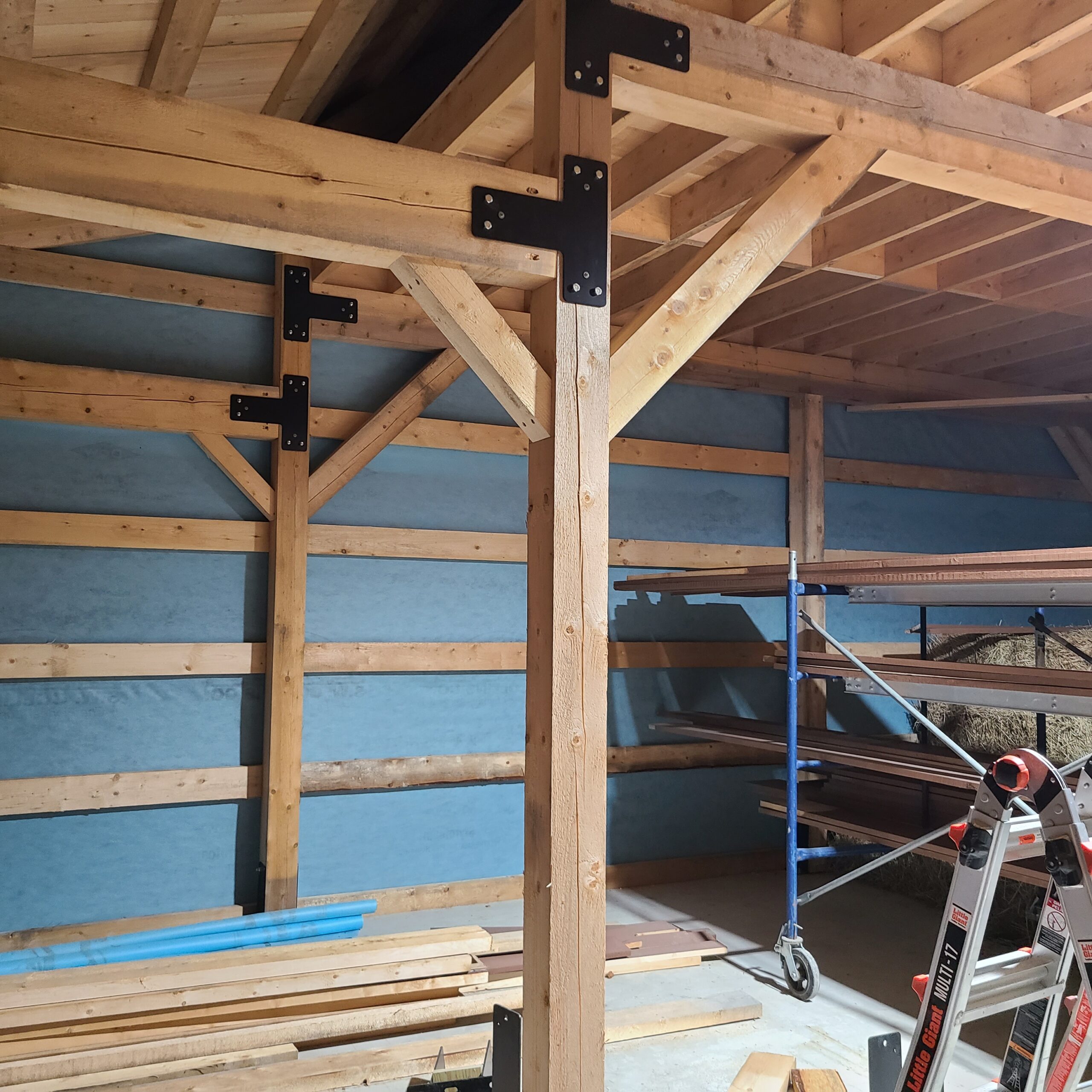
When building a barn, garage, or barndominium, choosing the right joinery method for your timber frame is a big decision. At BarnGeek, we believe that both traditional mortise and tenon joinery and modern steel plate connectors offer good solutions in the right situations. This article will walk you through how each method works, compare the pros and cons, and help you decide which option is right for your project. Whether you’re building yourself or hiring help on a budget, we want to make sure you’re informed and confident in your choice.
Mortise & Tenon Joinery
What It Is:
Mortise and tenon joints are a time-tested wood-on-wood connection where a “tenon” (a tongue-shaped projection) fits into a “mortise” (a hole or slot cut to receive it). This method has been used for centuries and is at the heart of many old barns that still stand today. As we like to say at BarnGeek, “At the center of every old barn is a beautiful hand-built mortise and tenon structure.”
Why It’s Loved:
- Classic Look: Mortise and tenon connections create an all-wood aesthetic with no visible hardware. This is ideal for projects emphasizing rustic or historical charm.
- Structural Integrity: Properly executed, these joints offer strong mechanical connections and excellent load distribution. Many mortise frames have lasted hundreds of years.
- Craftsmanship Appeal: There’s something special about the beauty and tradition of hand-cut joinery. Salvaged barn frames, like the Beemer Frame, feature massive hand-hewn oak beams full of character.
What to Consider:
- Skill Intensive: Creating mortise and tenon joints takes experience and precision. This isn’t a method most DIYers can tackle without serious training.
- Time & Labor: These joints require more shop time, which can drive up labor costs if you’re hiring help.
- Maintenance Myths: Some believe mortise joints “breathe” better and need less maintenance. The truth is, like any timber structure, they require proper forethought to make sure they shed water and prevent rot. Good roofing, flashing, and drainage are essential for decades to centuries of enduring character.
Steel Plate Joinery
What It Is:
Modern steel plate joinery uses custom-cut steel brackets and high-strength bolts to connect timber beams. Our BarnGeek hardware kits come with 1/4″ thick CNC-cut steel plates, pre-punched for bolts and designed to make construction simple.
Why It’s Popular:
- DIY-Friendly: Our kits are made for builders who don’t have advanced timber-framing skills. You simply follow the construction guide and bolt the frame together.
- Quick to Assemble: No complex joinery or chiseling required. With the right tools and basic carpentry know-how, you can erect a strong frame in less time.
- Strong as Steel: These connections are stronger than traditional mortise joints and allow for wider spans and more flexibility in design.
- Low Maintenance: The steel won’t rot. Our plates are offered with black powder coating (or bare steel) for long-term protection and aesthetic appeal.
What to Consider:
- Industrial Look: Exposed hardware changes the visual vibe. Some builders love the modern contrast of black steel on wood; others prefer to cover or blend the plates.
- Material Cost vs. Labor Savings: Steel plates add some upfront cost, but the time and labor saved often make up for it. In fact, many of our customers build full post-and-beam homes for less than conventional stick-built prices.
Side-by-Side Comparison
- Strength: Both methods create strong, long-lasting frames. Our steel-plate connections are engineered to exceed mortise joint strength.
- Durability: Steel plates (especially when coated) resist decay. Wood joints must stay dry, but both systems rely on good design to prevent moisture buildup.
- Skill Level: Mortise and tenon = advanced woodworking. Steel plate kits = perfect for DIYers or general contractors.
- Labor & Time: Mortise joinery takes more time and skill. Steel plate kits assemble quickly with common tools.
- Aesthetics: Mortise joints offer a seamless wood look. Steel plates add an industrial or modern touch.
- Maintenance: Neither system requires routine maintenance if properly built. Focus on good roof and drainage design.
Which Should You Choose?
Go with Mortise & Tenon if:
- You’re restoring a historic structure.
- You value hand-crafted aesthetics.
- You have access to skilled labor or love the woodworking challenge.
- and you have lot’s of extra time!
Go with Steel Plates if:
- You’re building on a budget or short timeline.
- You want to do it yourself without needing timber framing experience.
- You prefer the industrial-modern look or want maximum structural strength.
Why Not Both?
Some builders mix methods—using steel for the main frame and adding mortise joints in decorative or visible areas. Our kits support this flexibility with detailed plans and versatile hardware.
BarnGeek Has You Covered
Whether you want to embrace traditional joinery or streamline your build with steel plates, we provide:
- Hardware Kits with all plates, screws, and bolts you need.
- Digital Plans and 3D guides to walk you through the entire build.
- Support for DIYers via our forums, videos, and “Ask a BarnGeek” help line.
- Plan Subscriptions that give access to dozens of frame styles and tutorials.
At BarnGeek, we’re here to help you build strong, beautiful, and budget-friendly timber frames. Choose the joinery that fits your goals—and let’s build something great together.
Explore our full line of hardware kits and plans at barngeek.com.

Recent Comments